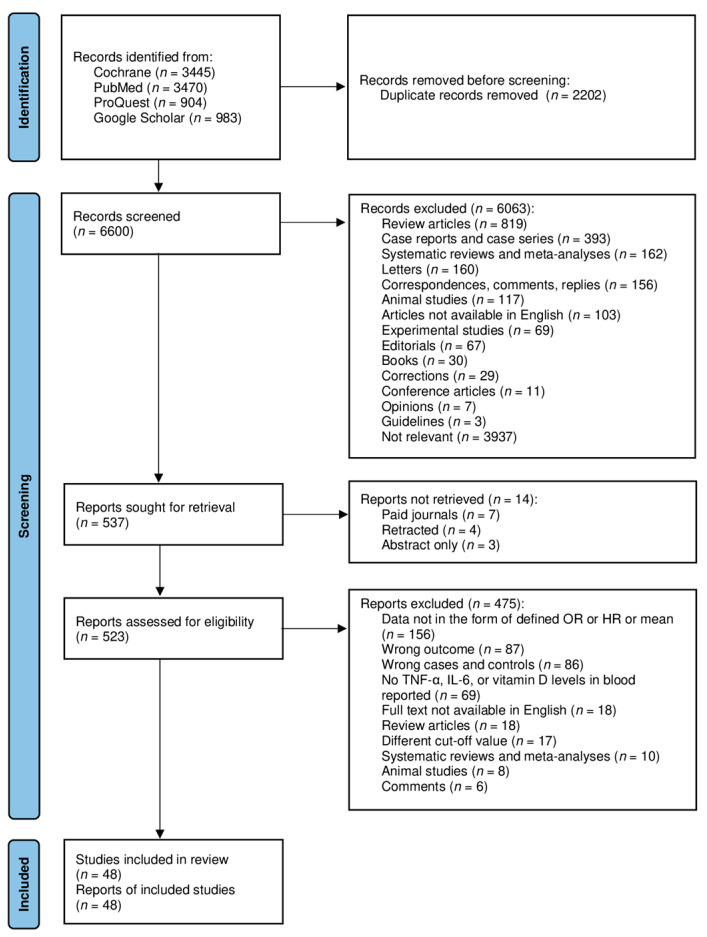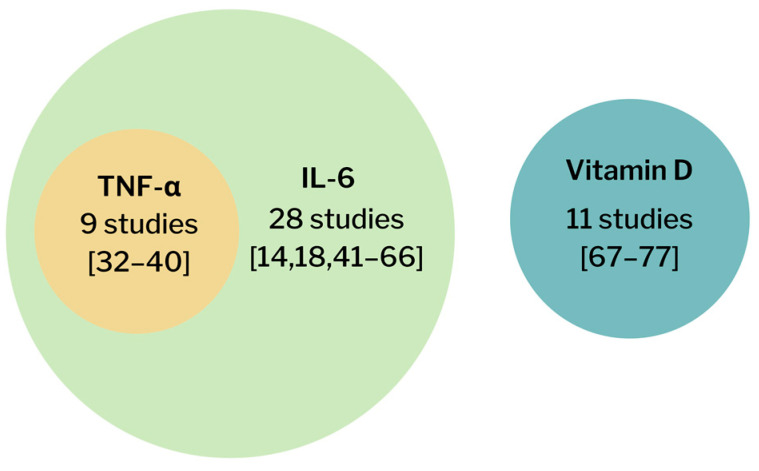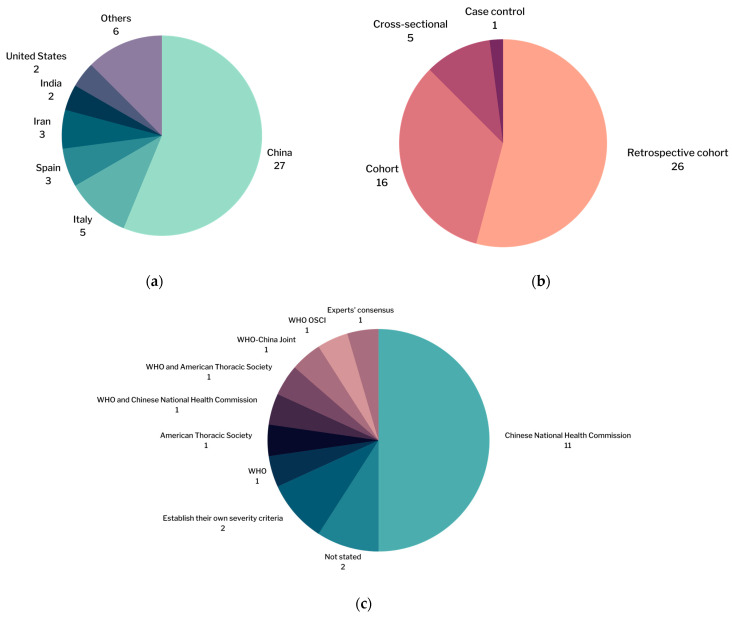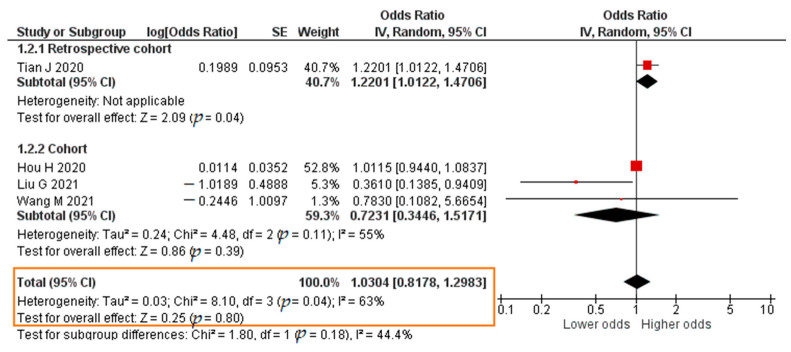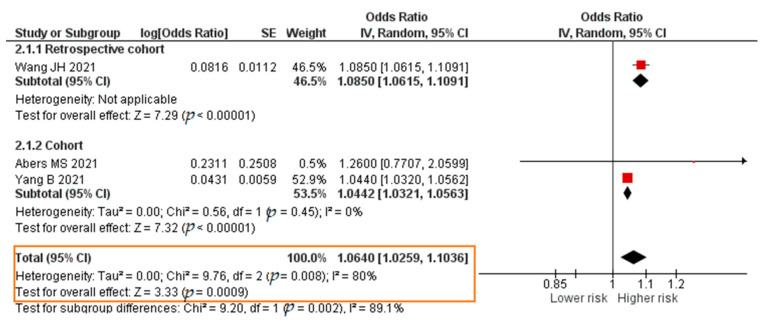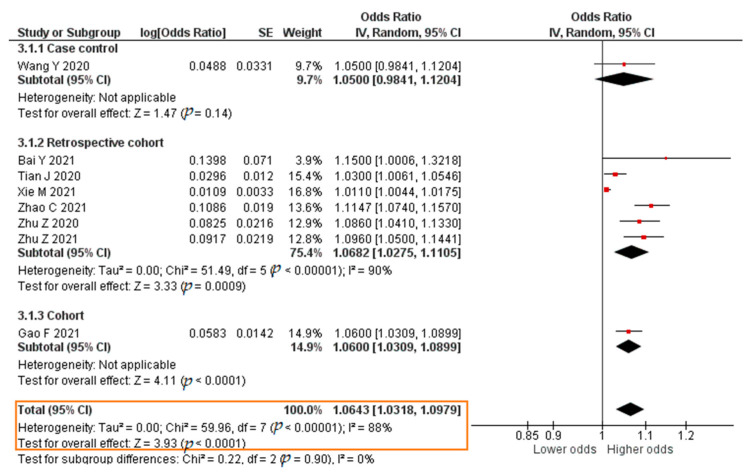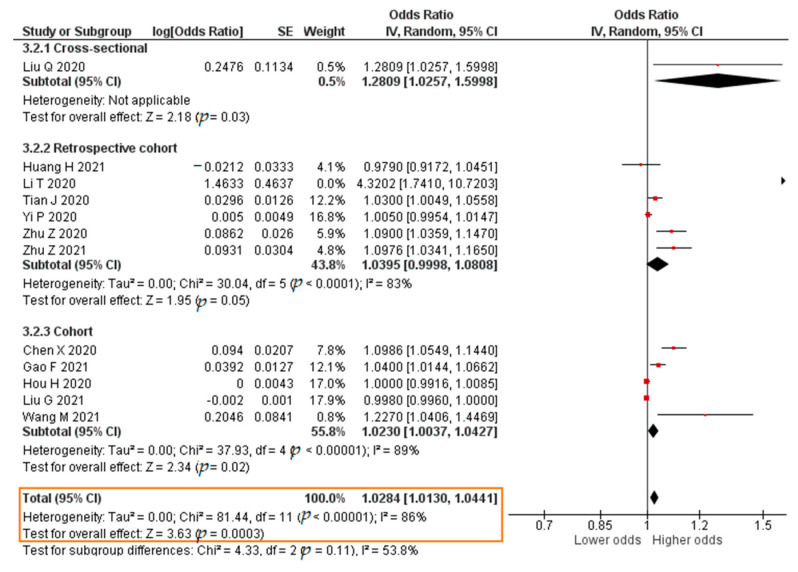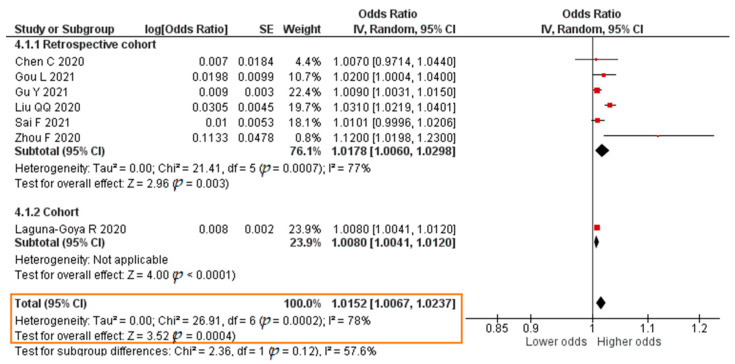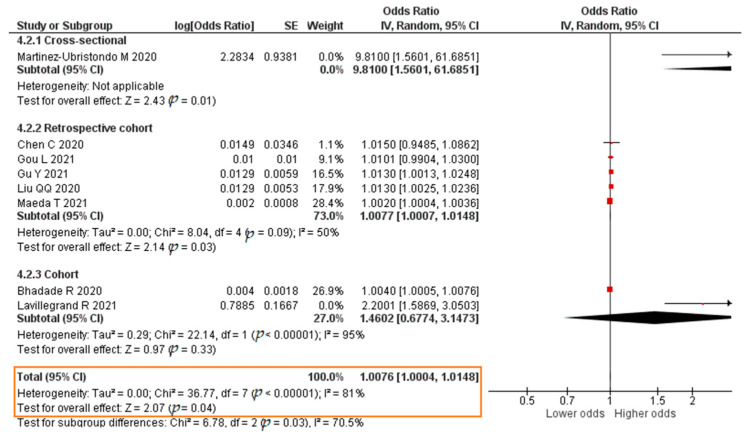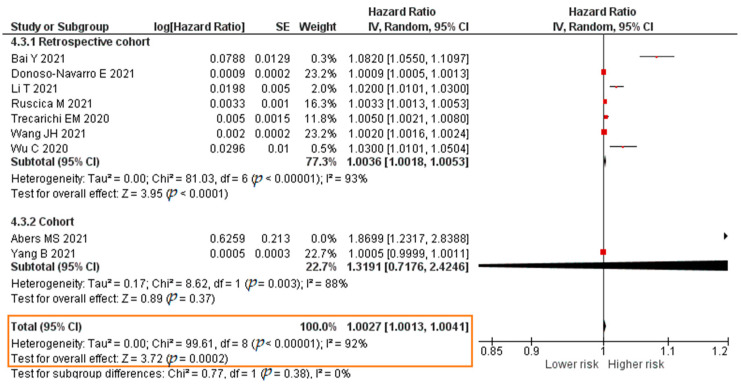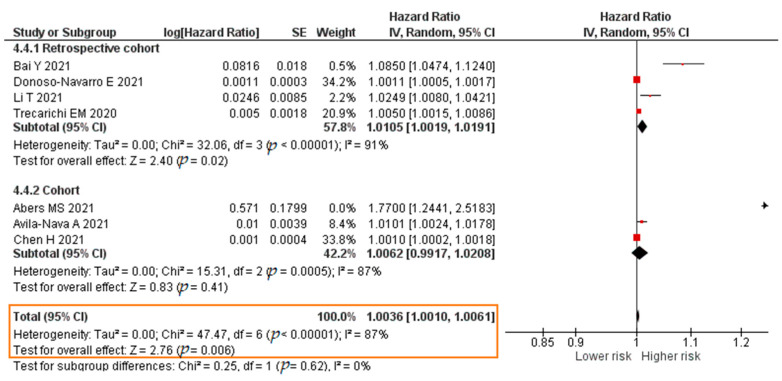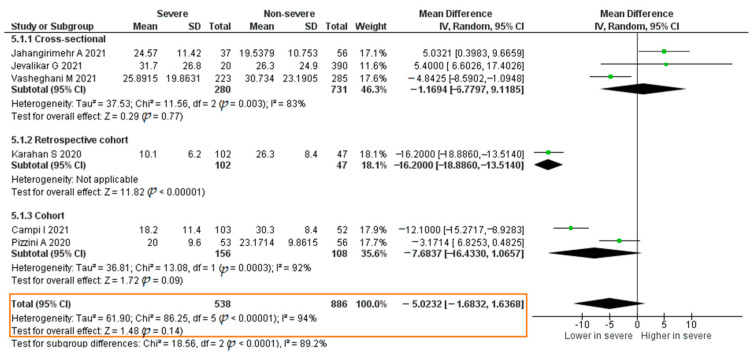Abstract
Background: An increasing number of scientific journals have proposed a connection between tumor necrosis factor-α (TNF-α) and interleukin-6 (IL-6) and the severity of COVID-19. Vitamin D has been discussed as a potential therapy for COVID-19 due to its immunomodulatory effects. This meta-analysis aims to determine the relationship, if any, between TNF-α, IL-6, vitamin D, and COVID-19 severity and mortality. Methods: The design of the study is a systematic review and meta-analysis. A literature search is performed using PubMed, Cochrane, ProQuest, and Google Scholar. Results: TNF-α insignificantly increases the risk of COVID-19 severity (adjusted odds ratio (aOR) = 1.0304; 95% CI 0.8178–1.2983; p = 0.80) but significantly increases the risk of COVID-19 mortality (crude hazard ratio (HR) = 1.0640; 95% CI 1.0259–1.1036; p = 0.0009). IL-6 significantly increases the risk of COVID-19 severity (aOR = 1.0284; 95% CI 1.0130–1.0441; p = 0.0003) and mortality (aOR = 1.0076; 95% CI 1.0004–1.0148; p = 0.04; adjusted hazard ratio (aHR) = 1.0036; 95% CI 1.0010–1.0061; p = 0.006). There is a statistically insignificant difference of the mean vitamin D levels between patients with severe COVID-19 and non-severe COVID-19 (mean difference (MD) = −5.0232; 95% CI 11.6832–1.6368; p = 0.14). A vitamin D deficiency insignificantly increases the risk of mortality of COVID-19 patients (aOR = 1.3827; 95% CI 0.7103–2.6916; p = 0.34). Conclusion: IL-6 is an independent prognostic factor towards COVID-19 severity and mortality.
Keywords: TNF-α, IL-6, vitamin D, COVID-19
1. Introduction
Coronavirus disease 2019 (COVID-19) was first reported in Wuhan, China. On 11 March 2020, the World Health Organization (WHO) declared COVID-19 to be a pandemic [1]. The three main symptoms of COVID-19 are a fever, cough, and shortness of breath. COVID-19 symptoms range from an asymptomatic infection to mild, moderate, severe, and critical such as acute respiratory distress syndrome (ARDS) [2]. Mortality has reached 39% to 45% in patients with ARDS [3,4]. In the United States, COVID-19 was the third most common cause of death in 2020, exceeding strokes and diabetes [5]. In Indonesia, the COVID-19 death toll reached 47,823 cases on 15 May 2021 [6].
Previous studies have proposed an association between immunopathogenesis and the clinical manifestation of COVID-19 [7,8,9]. A cytokine storm in COVID-19 patients causes apoptosis of the endothelial cells and epithelial cells as well as plasma leakage that can lead to lethal conditions such as ARDS, severe pneumonia, multiple organ failure, and shock [9,10,11].
Previous research has reported a significant difference of interleukin-6 (IL-6) levels between severe COVID-19 patients and non-severe COVID-19 patients [12,13,14,15,16,17,18]. Similar results were also observed on tumor necrosis factor-α (TNF-α) levels in COVID-19 patients [19,20,21,22,23].
Vitamin D has emerged as one of the proposed therapies for COVID-19. An association between COVID-19 severity and vitamin D deficiency (VDD) was reported by previous studies [24,25]. This finding was supported by previous studies that reported that vitamin D decreased the TNF-α and IL-6 concentration in the blood [26,27,28]. Other studies have reported the effect of vitamin D in increasing the Treg count and reducing inflammation [29,30].
This study aims to investigate whether TNF-α, IL-6, and vitamin D levels are associated with COVID-19 severity and mortality. This study differs from previous meta-analyses for the reason that this meta-analysis analyzes the odds ratios from logistic regression analyses and hazard ratios from Cox regression analyses. Furthermore, the odds ratios and hazard ratios are adjusted for other potentially confounding variables. In addition, this meta-analysis also includes the most recent studies up to the year 2021 to provide more comprehensive results.
2. Results
2.1. Literature Search
A total of 8802 records were identified across 4 databases using the search strategy described below. No additional articles or abstracts were selected from other sources. After 2202 duplicates were removed, 6600 citations were screened based on the title and abstract. Deduplication was carried out using the Rayyan application [31]. Five hundred and thirty-seven articles passed the initial screening and were further reviewed. Fourteen records did not have their full text available for retrieval. Five hundred and twenty-three full-text articles were reviewed and excluded based on the exclusion criteria. The exclusion reasons are shown in Figure 1. A total of 48 articles were included in the systematic review and meta-analysis with a sample size of 14,412 patients.
Figure 1.
Article selection process flow diagram.
2.2. Study Characteristics
Forty-eight studies were included in this meta-analysis. This meta-analysis analyzed the association between the levels of TNF-α, IL-6, and vitamin D and the severity and mortality of COVID-19. There were nine studies that analyzed the association between TNF-α and the severity and mortality of COVID-19 [32,33,34,35,36,37,38,39,40]. Along with those 9 studies, an additional 28 studies analyzed the association between the IL-6 level and the severity and mortality of COVID-19 [14,18,41,42,43,44,45,46,47,48,49,50,51,52,53,54,55,56,57,58,59,60,61,62,63,64,65,66]. A total of 11 studies analyzed the association between the vitamin D level and the severity and mortality of COVID-19 [67,68,69,70,71,72,73,74,75,76,77]. A Venn diagram is provided (Figure 2). The number of studies included in each analysis is listed in Figure 3. The number of patients in each analysis is listed in Figure 4.
Figure 2.
Venn diagram of the number of included studies.
Figure 3.
Number of studies included in: (a) TNF-α analysis; (b) IL-6 analysis; (c) vitamin D analysis.
Figure 4.
Number of patients included in: (a) TNF-α analysis; (b) IL-6 analysis; (c) vitamin D analysis.
The general characteristics of the studies are listed in Supplementary Table S1. All studies analyzed in this meta-analysis were published in 2020–2021. The dominant study location was China with a total of 27 studies (Figure 5a). Of the 48 included studies, the majority (26 studies) had a retrospective cohort study design (Figure 5b). A total of 22 studies analyzed the association between TNF-α, IL-6, and vitamin D levels and the severity of COVID-19. The most widely used severity criterion was the COVID-19 severity criterion from the Chinese National Health Commission, which was used by 11 studies (Figure 5c).
Figure 5.
Number of studies by: (a) study locations; (b) study designs; (c) severity criteria used.
2.3. TNF-α and COVID-19 Severity
There were 6 studies that analyzed the association between the TNF-α level and severe COVID-19; these reported an odds ratio (OR) value from a logistic regression analysis with the TNF-α level as a continuous variable. The total sample was 1535 patients. The results of each study are listed in Supplementary Table S2.
A total of 3 studies reported results in the form of a crude OR. The results of the meta-analysis were that each increase in the TNF-α level of 1 pg/mL significantly increased the risk of developing severe COVID-19 (crude OR = 1.1004; 95% CI 1.0185–1.1890; p = 0.02). The forest plot can be in Figure 6. Four studies reported results in the form of an adjusted odds ratio (aOR). The meta-analysis showed that each increase in the TNF-α level of 1 pg/mL insignificantly increased the risk of developing severe COVID-19 (aOR = 1.0304; 95% CI 0.8178–1.2983; p = 0.80). The forest plot can be seen in Figure 7.
Figure 6.
Forest plot of the crude odds ratio of severe COVID-19 with increased TNF-α levels. SE, standard error; IV, inverse variance; CI, confidence interval.
Figure 7.
Forest plot of the adjusted odds ratio of severe COVID-19 with increased TNF-α levels. SE, standard error; IV, inverse variance; CI, confidence interval.
2.4. TNF-α and COVID-19 Mortality
Three studies analyzed the association between the TNF-α level and COVID-19 mortality; these reported an HR value from a Cox regression analysis with the TNF-α level as a continuous variable. The total sample was 1630 patients. The results of each study are listed in Supplementary Table S3.
All three studies reported results in the form of a crude hazard ratio (HR). The results of the meta-analysis were that each increase in the TNF-α level of 1 pg/mL significantly increased the risk of mortality of COVID-19 patients (crude HR = 1.0640; 95% CI 1.0259–1.1036; p = 0.0009). The forest plot can be seen in Figure 8.
Figure 8.
Forest plot of the crude hazard ratio of COVID-19 mortality with increased TNF-α levels. SE, standard error; IV, inverse variance; CI, confidence interval.
2.5. IL-6 and COVID-19 Severity
Sixteen studies analyzed the association between the IL-6 level and severe COVID-19; these reported OR values from a logistic regression analysis. The total sample was 6063 patients. The results of each study are listed in Supplementary Table S4.
A total of eight studies reported results in the form of a crude OR. The results showed that each increase in the IL-6 level of 1 pg/mL significantly increased the risk of developing severe COVID-19 (crude OR = 1.0643; 95% CI 1.0318–1.0979; p < 0.0001). The forest plot can be seen in Figure 9. Twelve studies reported results in the form of an aOR. The results of the meta-analysis were that each increase in the IL-6 level of 1 pg/mL significantly increased the risk of developing severe COVID-19 (aOR = 1.0284; 95% CI 1.0130–1.0441; p = 0.0003). The forest plot can be seen in Figure 10.
Figure 9.
Forest plot of the crude odds ratio of severe COVID-19 with increased IL-6 levels. SE, standard error; IV, inverse variance; CI, confidence interval.
Figure 10.
Forest plot of the adjusted odds ratio of severe COVID-19 with increased IL-6 levels. SE, standard error; IV, inverse variance; CI, confidence interval.
2.6. IL-6 and COVID-19 Mortality
Eleven studies analyzed the relationship between IL-6 and COVID-19 mortality; these reported OR values from a logistic regression analysis. The total sample was 2213 patients. The reported results of each study are listed in Supplementary Table S5.
Seven studies reported results in the form of a crude OR. The meta-analysis result was that each increase in the IL-6 level of 1 pg/mL significantly increased the risk of mortality of COVID-19 patients (crude OR = 1.0152; 95% CI 1.0067–1.0237; p = 0.0004). The forest plot can be seen in Figure 11. Eight studies published results in the form of an aOR. The result of the meta-analysis showed that each increase in the IL-6 level of 1 pg/mL significantly increased the risk of mortality of COVID-19 patients (aOR = 1.0076; 95% CI 1.0004–1.0148; p = 0.04). The forest plot can be seen in Figure 12.
Figure 11.
Forest plot of the crude odds ratio of COVID-19 mortality with increased IL-6 levels. SE, standard error; IV, inverse variance; CI, confidence interval.
Figure 12.
Forest plot of the adjusted odds ratio of COVID-19 mortality with increased IL-6 levels. SE, standard error; IV, inverse variance; CI, confidence interval.
Eleven studies analyzed the association between the IL-6 level and COVID-19 mortality; these reported HR values from a Cox regression analysis. The total sample was 6715 patients. The results of each study are listed in Supplementary Table S6.
A total of nine studies reported results in the form of a crude HR. The meta-analysis showed that each increase in the IL-6 level of 1 pg/mL significantly increased the risk of mortality of COVID-19 patients (crude HR = 1.0027; 95% CI 1.0013–1.0041; p = 0.0002). The forest plot can be seen in Figure 13. A total of seven studies reported results in the form of an adjusted hazard ratio (aHR). The result of the meta-analysis showed that each increase in the IL-6 level of 1 pg/mL significantly increased the risk of mortality of COVID-19 patients (aHR = 1.0036; 95% CI 1.0010–1.0061; p = 0.006). The forest plot can be seen in Figure 14.
Figure 13.
Forest plot of the crude hazard ratio of COVID-19 mortality with increased IL-6 levels. SE, standard error; IV, inverse variance; CI, confidence interval.
Figure 14.
Forest plot of the adjusted hazard ratio of COVID-19 mortality with increased IL-6 levels. SE, standard error; IV, inverse variance; CI, confidence interval.
2.7. Vitamin D and COVID-19 Severity
There were six studies that analyzed the association between the vitamin D level and severe COVID-19; these reported the mean vitamin D levels. The studies were assessed for quality using the Newcastle–Ottawa Scale. The total sample was 1424 patients. The results of each study are listed in Supplementary Table S7.
The result of the meta-analysis was that the vitamin D levels of severe COVID-19 patients were not significantly lower than those in non-severe COVID-19 patients (mean difference (MD) = −5.0232; 95% CI −11.6832–1.6368; p = 0.14). The forest plot can be seen in Figure 15.
Figure 15.
Forest plot of the mean difference of vitamin D levels between severe COVID-19 patients and non-severe COVID-19 patients. SE, standard error; IV, inverse variance; CI, confidence interval.
2.8. Vitamin D and COVID-19 Mortality
Five studies analyzed the association between VDD and COVID-19 mortality; these reported OR values from a logistic regression analysis. VDD was defined as 25(OH)D < 20 ng/mL [78]. The total sample was 1339 patients. The results of each study are listed in Supplementary Table S8.
Three studies reported results in the form of a crude OR. The results of the meta-analysis showed that VDD insignificantly increased the risk of mortality of COVID-19 patients (crude OR = 1.1505; 95% CI 0.5299–2.4977; p = 0.72). The forest plot can be seen in Figure 16. All five studies reported results in the form of an aOR. The results were that VDD insignificantly increased the risk of mortality of COVID-19 patients (aOR = 1.3827; 95% CI 0.7103–2.6916; p = 0.34). The forest plot can be seen in Figure 17.
Figure 16.
Forest plot of the crude odds ratio of COVID-19 mortality with vitamin D deficiency. SE, standard error; IV, inverse variance; CI, confidence interval.
Figure 17.
Forest plot of the adjusted odds ratio of COVID-19 mortality with vitamin D deficiency. SE, standard error; IV, inverse variance; CI, confidence interval.
3. Discussion
TNF-α triggers and amplifies acute inflammatory reactions with characteristics of rubor, calor, dolor, and tumor [79]. TNF-α is one of the endogenous pyrogens that increases the body temperature and causes fever [80] (pp. 88–89). Large quantities of TNF-α are pathological to the organ systems. TNF-α can inhibit myocardial contractility and lower blood pressure, resulting in shock. TNF-α activates the tissue factor, which plays a role in the blood coagulation cascade [80] (p. 89).
The findings of this study were supported by the results of a previous study by Merza et al. [81], which reported that the mean TNF-α levels were not significantly higher in patients with severe COVID-19 compared with non-severe COVID-19 patients. A previous meta-analysis by Mulchandani et al. [82], however, reported that the mean TNF-α levels were significantly higher in patients with severe COVID-19 compared with non-severe COVID-19 patients. Several prior studies also presented that the TNF-α levels in severe COVID-19 patients were significantly higher than non-severe COVID-19 patients [19,21,83].
The mean TNF-α levels were found to be significantly higher in COVID-19 patients who died compared with COVID-19 survivors [84,85,86]. A previous study by Liu et al. [56] published that increased levels of TNF-α did not significantly reduce the risk of mortality in COVID-19 patients (aOR = 0.957; 95% CI 0.857–1.068; p = 0.429).
IL-6 is a pro-inflammatory cytokine that plays a role in the acute inflammatory reaction. IL-6 increases the leukocyte migration to areas of inflammation, increases the division of B cells that produce antibodies, and plays a role in Th17 differentiation in T cells [80] (pp. 85–87, 92). IL-6 activates the intracellular cascade of Jak/STAT (Janus kinases/signal transducers and activators of transcription) [87]. The inflammatory cascade of IL-6 through STAT3 forms a positive feedback loop—namely, the IL-6 amplifier (IL-6 AMP)—in non-immune cells. As a result, NF-κB hyperactivation occurs, which in turn produces an excessive number of cytokines, also known as a cytokine storm. A cytokine storm in COVID-19 patients is known to cause fatal conditions such as ARDS, severe pneumonia, multiple organ failure, and coagulation [10].
The mean IL-6 levels were recorded to be significantly higher in patients with severe COVID-19 compared with non-severe COVID-19 patients [15,16,88,89,90,91,92,93,94]. Additionally, IL-6 was also reported as an independent predictor of ICU admission [95]. The results of this meta-analysis were also in line with a previous meta-analysis of RCTs that presented a reduction in the incidence of intubation in COVID-19 patients receiving IL-6 inhibitors [96].
Higher mean IL-6 levels in COVID-19 deaths than in COVID-19 survivors were also reported by a previous meta-analysis [88]. Another study recorded that the mean IL-6 levels were 2.9 times higher in complicated COVID-19 patients compared with uncomplicated COVID-19 patients [97]. A meta-analysis of RCTs reported a decreased incidence of death in COVID-19 patients receiving IL-6 inhibitors [96].
Vitamin D is known to possess an anti-inflammatory effect. Vitamin D is reported to suppress the production of reactive oxygen species and myeloperoxidase in neutrophils as well as suppressing Th1 and Th17 activities, reducing the levels of pro-inflammatory cytokines, and increasing Th2 and Treg activities [26,29,30,98]. Vitamin D also inhibits the transcription factor NF-κB, which plays a role in the production of pro-inflammatory cytokines [98].
A previous study by AlSafar et al. [67] found VDD did not significantly increase the risk of severe COVID-19. Significantly lower vitamin D levels in severe COVID-19 patients than non-severe COVID-19 patients were reported by a prior meta-analysis [99]. VDD was associated with an increased risk of severe COVID-19 and vitamin D possessed a protective effect against the incidence of severe COVID-19 (OR = 0.91; 95% CI 0.84–0.99) [100]. VDD was estimated to cause a six-fold increased risk of developing severe COVID-19 [25].
No significant relationship was observed between an increased risk of mortality and VDD in studies using logistic regression analyses [100]. Another study noted no significant difference in the mean vitamin D levels between COVID-19 patients who died and COVID-19 survivors [101]. These results were in contrast to several other previous studies. VDD was estimated to cause a 15-fold increased risk of COVID-19 mortality [25]. A significant difference was recorded in the mean vitamin D levels between COVID-19 patients who died and COVID-19 survivors [73,77,102,103,104].
To our knowledge, the present meta-analysis—which included 14,412 patients from 48 studies—was the first study to analyze the OR and HR values between TNF-α, IL-6, and vitamin D and COVID-19 severity and mortality. The OR and HR values were more applicable to a clinical situation in calculating the risk of a patient rather than the mean difference values. Furthermore, these OR and HR values were adjusted for other variables whereas other studies using the mean did not. This meta-analysis also included studies up to the year 2021 to produce up-to-date results.
This study had several limitations. First, the differences between our results and the results of previous studies may be due to too few studies being included in our analysis. There are limited studies regarding COVID-19 due to the novelty of this disease. Our inclusion and exclusion criteria were more selective, resulting in fewer studies remaining after the selection process. For example, we excluded composite outcomes of severity and mortality to provide a better distinction between these two. There were also studies excluded due to different VDD cut-off values. These criteria ensured a more consistent result among the studies. Another limitation of this study was that the analyzed studies were mostly conducted in China. Thus, a potential bias due to a similar location and population cannot be ruled out.
4. Materials and Methods
A literature search was conducted on PubMed, Cochrane, ProQuest, and Google Scholar on 6 August 2021. The literature search was conducted with the keywords “COVID-19 AND (Tumor Necrosis Factor-alpha OR Interleukin-6 OR Vitamin D)”. The medical subject headings (MeSH) words and detailed search strategies are provided in Supplementary Text S1. The search results were compiled and deduplicated using Rayyan [31].
The studies included in this meta-analysis were studies with a population of COVID-19 patients and outcomes of severe COVID-19 and COVID-19 deaths. The inclusion criteria were: studies with a population of COVID-19 patients; available data of TNF-α, IL-6, and vitamin D levels in the blood; complete data were available; and the study was available in English. The exclusion criteria were: review articles; systematic reviews; meta-analyses; correspondence; letters; replies; comments; case reports; case series; paid journals; duplication; and research conducted on animals. In addition, studies that observed a composite severity outcome with mortality as one of the elements were excluded and regarded as studies with the wrong outcome. VDD was defined as 25(OH)D < 20 ng/mL [78]. Studies with different VDD cut-off points were excluded. The records were screened manually by one reviewer (CH).
All relevant data were collected using data collection standards set by two reviewers working together (CH and MIS). The collected data were the name of the first author, year of publication, number of patients, inclusion criteria, exclusion criteria, and levels of TNF-α, IL-6, and vitamin D. The data collected for TNF-α and IL-6 analyses were the OR from a logistic regression analysis or the HR from a Cox regression analysis. The data collected for vitamin D analyses were the mean and standard deviation (SD) or the OR from a logistic regression analysis. Missing and incomplete data were not sought further.
A quality assessment of the studies was carried out by two reviewers (CH and MIS). Studies with mean levels were assessed for quality using the NOS (The Newcastle–Ottawa Scale) [105]. The NOS criteria in the cross-sectional studies were adapted from the cohort criteria [106].
The odds ratio (OR), hazard ratio (HR), mean difference (MD), and 95% confidence interval (CI) were analyzed using Review Manager 5.4 (The Cochrane Collaboration, Oxford, UK). A p-value < 0.05 indicated statistically significant data. The heterogeneity of the statistical data was indicated by the symbol I2. An I2 value < 25% indicated a low heterogeneity, an I2 value of 25–50% indicated a moderate heterogeneity, and an I2 value > 50% indicated a high heterogeneity [107]. The data were analyzed using a random effects model. The random effects model was chosen because the studies in this meta-analysis were conducted by different researchers operating independently [108] (pp. 83–86). The random effects model was selected without considering the heterogeneity [109]. The study hypothesis was measured by the Z-test. Z-scores greater or less than ± 1.96 indicated that the results were significant [108] (pp. 257–258). All the results from the meta-analysis have been published in this article regardless of insignificant results.
5. Conclusions
The results of a literature search were 48 studies with a total sample of 14,412 patients. The majority of the included studies were located in China and the majority of the included studies had a retrospective cohort study design. Overall, the summary estimates of all analyses suggested that IL-6 was an independent prognostic factor toward COVID-19 severity and mortality. No definitive results were drawn regarding the association between TNF-α and vitamin D and COVID-19 severity and mortality. Further studies with more detailed information on other outcomes and cut-off values should be conducted especially in countries other than China to validate the association between these variables.
Acknowledgments
We sincerely thank all researchers who have contributed their studies in this field, without whom this meta-analysis would not be possible. We would also thank all medical workers who have dedicated their time and energy during these difficult times.
Supplementary Materials
The following are available online at https://www.mdpi.com/article/10.3390/pathogens11020195/s1, Table S1: Study characteristics, Table S2: Studies investigating the association between TNF-a and severe COVID-19 with odds ratio values, Table S3: Studies investigating the association between TNF-a and COVID-19 mortality with hazard ratio values, Table S4: Studies investigating the association between IL-6 and severe COVID-19 with odds ratio values, Table S5: Studies investigating the association between IL-6 and CoVID-19 mortality with odds ratio values, Table S6: Studies investigating the association between IL-6 and CoVID-19 mortality with hazard ratio values, Table S7: Studies investigating the association between vitamin D levels and severe CoVID-19 with mean vitamin D values, Table S8: Studies investigating the association between vitamin D deficiency and COVID-19 mortality, Text S1: Detailed search strategies and MeSH.
Author Contributions
Conceptualization, C.H. and M.I.S.; methodology, C.H. and M.I.S.; software, C.H.; validation, C.H. and A.F.M.; formal analysis, C.H.; investigation, C.H.; resources, C.H.; data curation, C.H.; writing—original draft preparation, C.H.; writing—review and editing, A.F.M. and M.I.S.; visualization, C.H.; supervision, M.I.S.; project administration, M.I.S.; funding acquisition, C.H. and M.I.S. All authors have read and agreed to the published version of the manuscript.
Funding
This research received no external funding.
Institutional Review Board Statement
The study was conducted according to the guidelines of the Declaration of Helsinki and approved by the Ethics Committee of Universitas Sumatera Utara (date of approval 31 August 2021).
Informed Consent Statement
Not applicable.
Data Availability Statement
Data are contained within the article or supplementary materials.
Conflicts of Interest
The authors declare no conflict of interest.
Footnotes
Publisher’s Note: MDPI stays neutral with regard to jurisdictional claims in published maps and institutional affiliations.
References
- 1.World Health Organization Rolling Updates on Coronavirus Disease (COVID-19) [(accessed on 24 April 2021)]. Available online: https://www.who.int/emergencies/diseases/novel-coronavirus-2019/events-as-they-happen.
- 2.Wu Z., McGoogan J.M. Characteristics of and Important Lessons from the Coronavirus Disease 2019 (COVID-19) Outbreak in China: Summary of a Report of 72 314 Cases from the Chinese Center for Disease Control and Prevention. JAMA. 2020;323:1239–1242. doi: 10.1001/jama.2020.2648. [DOI] [PubMed] [Google Scholar]
- 3.Hasan S.S., Capstick T., Ahmed R., Kow C.S., Mazhar F., Merchant H.A., Zaidi S.T.R. Mortality in COVID-19 patients with acute respiratory distress syndrome and corticosteroids use: A systematic review and meta-analysis. Expert Rev. Respir. Med. 2020;14:1149–1163. doi: 10.1080/17476348.2020.1804365. [DOI] [PMC free article] [PubMed] [Google Scholar]
- 4.Tzotzos S.J., Fischer B., Fischer H., Zeitlinger M. Incidence of ARDS and outcomes in hospitalized patients with COVID-19: A global literature survey. Crit. Care. 2020;24:1–4. doi: 10.1186/s13054-020-03240-7. [DOI] [PMC free article] [PubMed] [Google Scholar]
- 5.Ahmad F.B., Anderson R.N. The Leading Causes of Death in the US for 2020. JAMA. 2021;325:1829–1830. doi: 10.1001/jama.2021.5469. [DOI] [PMC free article] [PubMed] [Google Scholar]
- 6.Satuan Tugas Penanganan COVID-19 (COVID-19 Task Force) Peta Sebaran COVID-19 (COVID-19 Distribution Map) [(accessed on 15 May 2021)]. Available online: https://covid19.go.id/peta-sebaran-covid19.
- 7.Wiersinga W.J., Rhodes A., Cheng A.C., Peacock S.J., Prescott H.C. Pathophysiology, Transmission, Diagnosis, and Treatment of Coronavirus Disease 2019 (COVID-19): A Review. JAMA. 2020;324:728–793. doi: 10.1001/jama.2020.12839. [DOI] [PubMed] [Google Scholar]
- 8.Fara A., Mitrev Z., Rosalia R.A., Assas B.M. Cytokine storm and COVID-19: A chronicle of pro-inflammatory cytokines. Open Biol. 2020;10:1–12. doi: 10.1098/rsob.200160. [DOI] [PMC free article] [PubMed] [Google Scholar]
- 9.Yang L., Liu S., Liu J., Zhang Z., Wan X., Huang B., Chen Y., Zhang Y. COVID-19: Immunopathogenesis and Immunotherapeutics. Sig. Transduct. Target. Ther. 2020;5:1–8. doi: 10.1038/s41392-020-00243-2. [DOI] [PMC free article] [PubMed] [Google Scholar]
- 10.Hojyo S., Uchida M., Tanaka K., Hasebe R., Tanaka Y., Murakami M., Hirano T. How COVID-19 induces cytokine storm with high mortality. Inflamm. Regener. 2020;40:1–7. doi: 10.1186/s41232-020-00146-3. [DOI] [PMC free article] [PubMed] [Google Scholar]
- 11.Tang Y., Liu J., Zhang D., Xu Z., Ji J., Wen C. Cytokine Storm in COVID-19: The Current Evidence and Treatment Strategies. Front. Immunol. 2020;11:1–13. doi: 10.3389/fimmu.2020.01708. [DOI] [PMC free article] [PubMed] [Google Scholar]
- 12.Bao J., Li C., Zhang K., Kang H., Chen W., Gu B. Comparative analysis of laboratory indexes of severe and non-severe patients infected with COVID-19. Clin. Chim. Acta. 2020;509:180–194. doi: 10.1016/j.cca.2020.06.009. [DOI] [PMC free article] [PubMed] [Google Scholar]
- 13.Gao Y., Li T., Han M., Li X., Wu D., Xu Y., Zhu Y., Liu Y., Wang X., Wang L. Diagnostic utility of clinical laboratory data determinations for patients with the severe COVID-19. J. Med. Virol. 2020;92:791–796. doi: 10.1002/jmv.25770. [DOI] [PMC free article] [PubMed] [Google Scholar]
- 14.Gu Y., Wang D., Chen C., Lu W., Liu H., Lv T., Song Y., Zhang F. PaO2/FiO2 and IL-6 are risk factors of mortality for intensive care COVID-19 patients. Sci. Rep. 2021;11:1–8. doi: 10.1038/s41598-021-86676-3. [DOI] [PMC free article] [PubMed] [Google Scholar]
- 15.Lv Z., Cheng S., Le J., Huang J., Feng L., Zhang B., Li Y. Clinical characteristics and co-infections of 354 hospitalized patients with COVID-19 in Wuhan, China: A retrospective cohort study. Microbes Infect. 2020;22:195–199. doi: 10.1016/j.micinf.2020.05.007. [DOI] [PMC free article] [PubMed] [Google Scholar]
- 16.Sun H., Guo P., Zhang L., Wang F. Serum Interleukin-6 Concentrations and the Severity of COVID-19 Pneumonia: A Retrospective Study at a Single Center in Bengbu City, Anhui Province, China, in January and February 2020. Med. Sci. Monit. 2020;26:e926941. doi: 10.12659/MSM.926941. [DOI] [PMC free article] [PubMed] [Google Scholar]
- 17.Wei Y.Y., Wang R.R., Zhang D.W., Tu Y.H., Chen C.S., Ji S., Li C.X., Li X.Y., Zhou M.X., Cao W.S., et al. Risk factors for severe COVID-19: Evidence from 167 hospitalized patients in Anhui, China. J. Infect. 2020;81:e89–e92. doi: 10.1016/j.jinf.2020.04.010. [DOI] [PMC free article] [PubMed] [Google Scholar]
- 18.Yi P., Yang X., Ding C., Chen Y., Xu K., Ni Q., Zhao H., Li Y., Zhang X., Liu J., et al. Risk factors and clinical features of deterioration in COVID-19 patients in Zhejiang, China: A single-centre, retrospective study. BMC Infect. Dis. 2020;20:1–7. doi: 10.1186/s12879-020-05682-4. [DOI] [PMC free article] [PubMed] [Google Scholar]
- 19.Chen G., Wu D., Guo W., Cao Y., Huang D., Wang H., Wang T., Zhang X., Chen H., Yu H., et al. Clinical and immunological features of severe and moderate coronavirus disease 2019. J. Clin. Investig. 2020;130:2620–2629. doi: 10.1172/JCI137244. [DOI] [PMC free article] [PubMed] [Google Scholar]
- 20.Huang C., Wang Y., Li X., Ren L., Zhao J., Hu Y., Zhang L., Fan G., Xu J., Gu X., et al. Clinical features of patients infected with 2019 novel coronavirus in Wuhan, China. Lancet. 2020;395:497–506. doi: 10.1016/S0140-6736(20)30183-5. [DOI] [PMC free article] [PubMed] [Google Scholar]
- 21.Qin C., Zhou L., Hu Z., Zhang S., Yang S., Tao Y., Xie C., Ma K., Shang K., Wang W., et al. Dysregulation of Immune Response in Patients with Coronavirus 2019 (COVID-19) in Wuhan, China. Clin. Infect. Dis. 2020;71:762–768. doi: 10.1093/cid/ciaa248. [DOI] [PMC free article] [PubMed] [Google Scholar]
- 22.Del Valle D.M., Kim-Schulze S., Huang H.H., Beckmann N.D., Nirenberg S., Wang B., Lavin Y., Swartz T.H., Madduri D., Stock A., et al. An inflammatory cytokine signature predicts COVID-19 severity and survival. Nat. Med. 2020;26:1636–1643. doi: 10.1038/s41591-020-1051-9. [DOI] [PMC free article] [PubMed] [Google Scholar]
- 23.Yang A.P., Li H.M., Tao W.Q., Yang X.J., Wang M., Yang W.J., Liu J.P. Infection with SARS-CoV-2 causes abnormal laboratory results of multiple organs in patients. Aging. 2020;12:10059–10069. doi: 10.18632/aging.103255. [DOI] [PMC free article] [PubMed] [Google Scholar]
- 24.Baktash V., Hosack T., Patel N., Shah S., Kandiah P., Van den Abbeele K., Mandal A.K.J., Missouris C.G. Vitamin D status and outcomes for hospitalised older patients with COVID-19. Postgrad. Med. J. 2021;97:442–447. doi: 10.1136/postgradmedj-2020-138712. [DOI] [PMC free article] [PubMed] [Google Scholar]
- 25.Radujkovic A., Hippchen T., Tiwari-Heckler S., Dreher S., Boxberger M., Merle U. Vitamin D Deficiency and Outcome of COVID-19 Patients. Nutrients. 2020;12:2757. doi: 10.3390/nu12092757. [DOI] [PMC free article] [PubMed] [Google Scholar]
- 26.Leal L.K.A.M., Lima L.A., de Aquino P.E.A., de Sousa J.A.C., Gadelha C.V.J., Calou I.B.F., Lopes M.J.P., Lima F.A.V., Neves K.R.T., de Andrade G.M., et al. Vitamin D (VD3) antioxidative and anti-inflammatory activities: Peripheral and central effects. Eur. J. Pharmacol. 2020;879:1–12. doi: 10.1016/j.ejphar.2020.173099. [DOI] [PubMed] [Google Scholar]
- 27.Miroliaee A.E., Salamzadeh J., Shokouhi S., Sahraei Z. The study of vitamin D administration effect on CRP and Interleukin-6 as prognostic biomarkers of ventilator associated pneumonia. J. Crit. Care. 2018;44:300–305. doi: 10.1016/j.jcrc.2017.08.040. [DOI] [PubMed] [Google Scholar]
- 28.Peterson C.A., Heffernan M.E. Serum tumor necrosis factor-alpha concentrations are negatively correlated with serum 25(OH)D concentrations in healthy women. J. Inflamm. 2008;5:1–9. doi: 10.1186/1476-9255-5-10. [DOI] [PMC free article] [PubMed] [Google Scholar]
- 29.Cantorna M.T., Snyder L., Lin Y.D., Yang L. Vitamin D and 1,25(OH)2D regulation of T cells. Nutrients. 2015;7:3011–3021. doi: 10.3390/nu7043011. [DOI] [PMC free article] [PubMed] [Google Scholar]
- 30.Fisher S.A., Rahimzadeh M., Brierley C., Gration B., Doree C., Kimber C.E., Plaza Cajide A., Lamikanra A.A., Roberts D.J. The role of vitamin D in increasing circulating T regulatory cell numbers and modulating T regulatory cell phenotypes in patients with inflammatory disease or in healthy volunteers: A systematic review. PLoS ONE. 2019;14:e0222313. doi: 10.1371/journal.pone.0222313. [DOI] [PMC free article] [PubMed] [Google Scholar]
- 31.Ouzzani M., Hammady H., Fedorowicz Z., Elmagarmid A. Rayyan—A web and mobile app for systematic reviews. Syst. Rev. 2016;5:1–10. doi: 10.1186/s13643-016-0384-4. [DOI] [PMC free article] [PubMed] [Google Scholar]
- 32.Abers M.S., Delmonte O.M., Ricotta E.E., Fintzi J., Fink D.L., de Jesus A.A.A., Zarember K.A., Alehashemi S., Oikonomou V., Desai J.V., et al. An immune-based biomarker signature is associated with mortality in COVID-19 patients. JCI Insight. 2021;6:e144455. doi: 10.1172/jci.insight.144455. [DOI] [PMC free article] [PubMed] [Google Scholar]
- 33.Hou H., Zhang B., Huang H., Luo Y., Wu S., Tang G., Liu W., Mao L., Mao L., Wang F., et al. Using IL-2R/lymphocytes for predicting the clinical progression of patients with COVID-19. Clin. Exp. Immunol. 2020;201:76–84. doi: 10.1111/cei.13450. [DOI] [PMC free article] [PubMed] [Google Scholar]
- 34.Liu G., Jiang X., Zeng X., Pan Y., Xu H. Analysis of Lymphocyte Subpopulations and Cytokines in COVID-19-Associated Pneumonia and Community-Acquired Pneumonia. J. Immunol. Res. 2021;2021:1–9. doi: 10.1155/2021/6657894. [DOI] [PMC free article] [PubMed] [Google Scholar]
- 35.Tian J., Yuan X., Xiao J., Zhong Q., Yang C., Liu B., Cai Y., Lu Z., Wang J., Wang Y., et al. Clinical characteristics and risk factors associated with COVID-19 disease severity in patients with cancer in Wuhan, China: A multicentre, retrospective, cohort study. Lancet Oncol. 2020;21:893–903. doi: 10.1016/S1470-2045(20)30309-0. [DOI] [PMC free article] [PubMed] [Google Scholar]
- 36.Wang J.H., Chen R.D., Yang H.K., Zeng L.C., Chen H., Hou Y.Y., Hu W., Yu J.S., Li H. Inflammation-associated factors for predicting in-hospital mortality in patients with COVID-19. J. Med. Virol. 2021;93:2908–2917. doi: 10.1002/jmv.26771. [DOI] [PubMed] [Google Scholar]
- 37.Wang M., Fan Y., Chai Y., Cheng W., Wang K., Cao J., Hu X. Association of Clinical and Immunological Characteristics With Disease Severity and Outcomes in 211 Patients With COVID-19 in Wuhan, China. Front. Cell Infect. Microbiol. 2021;11:667487:1–667487:21. doi: 10.3389/fcimb.2021.667487. [DOI] [PMC free article] [PubMed] [Google Scholar]
- 38.Xie M., Yunis J., Yao Y., Shi J., Yang Y., Zhou P., Liang K., Wan Y., Mehdi A., Chen Z., et al. High levels of soluble CD25 in COVID-19 severity suggest a divergence between anti-viral and pro-inflammatory T-cell responses. Clin. Transl. Immunol. 2021;10:e1251. doi: 10.1002/cti2.1251. [DOI] [PMC free article] [PubMed] [Google Scholar]
- 39.Yang B., Chang X., Huang J., Pan W., Si Z., Zhang C., Li H. The role of IL-6/lymphocyte ratio in the peripheral blood of severe patients with COVID-19. Int. Immunopharmacol. 2021;97:1–8. doi: 10.1016/j.intimp.2021.107569. [DOI] [PMC free article] [PubMed] [Google Scholar]
- 40.Zhu Z., Cai T., Fan L., Lou K., Hua X., Huang Z., Gao G. Clinical value of immune-inflammatory parameters to assess the severity of coronavirus disease 2019. Int. J. Infect. Dis. 2020;95:332–339. doi: 10.1016/j.ijid.2020.04.041. [DOI] [PMC free article] [PubMed] [Google Scholar]
- 41.Avila-Nava A., Cortes-Telles A., Torres-Erazo D., López-Romero S., Chim Aké R., Gutiérrez Solis A.L. Serum IL-6: A potential biomarker of mortality among SARS-CoV-2 infected patients in Mexico. Cytokine. 2021;143:1–6. doi: 10.1016/j.cyto.2021.155543. [DOI] [PMC free article] [PubMed] [Google Scholar]
- 42.Bai Y., Wang E., Zhao S., Li J., Zhu Y., Zhang Y., Cao L., Liu H., Dong Y., Wang F., et al. Implications of Laboratory Tests in Disease Grading and Death Risk Stratification of COVID-19: A Retrospective Study in Wuhan, China. Front. Med. (Lausanne) 2021;8:1–9. doi: 10.3389/fmed.2021.629296. [DOI] [PMC free article] [PubMed] [Google Scholar]
- 43.Bhadade R., Harde M., deSouza R., Kasbe A., Deshpande C., Dave S., Joshi M., Bharmal R., Madke T. Appraisal of Critically Ill COVID-19 Patients at a Dedicated COVID Hospital. J. Assoc. Physicians India. 2020;68:14–19. [PubMed] [Google Scholar]
- 44.Chen C., Zhang J., Li C., Hu Z., Zhang M., Tu P., Liu L., Zong W. The characteristics and death risk factors of 132 COVID-19 pneumonia patients with comorbidities: A retrospective single center analysis in Wuhan, China. medRxiv. 2021 doi: 10.1101/2020.05.07.20092882. [DOI] [Google Scholar]
- 45.Chen H., Chen R., Yang H., Wang J., Hou Y., Hu W., Yu J., Li H. Development and validation of a nomogram using on admission routine laboratory parameters to predict in-hospital survival of patients with COVID-19. J. Med. Virol. 2021;93:2332–2339. doi: 10.1002/jmv.26713. [DOI] [PubMed] [Google Scholar]
- 46.Chen X., Huang J., Huang Y., Chen J., Huang Y., Jiang X., Shi Y. Characteristics of immune cells and cytokines in patients with coronavirus disease 2019 in Guangzhou, China. Hum. Immunol. 2020;81:702–708. doi: 10.1016/j.humimm.2020.08.006. [DOI] [PMC free article] [PubMed] [Google Scholar]
- 47.Donoso-Navarro E., Arribas Gómez I., Bernabeu-Andreu F.A. IL-6 and Other Biomarkers associated with Poor Prognosis in a Cohort of Hospitalized Patients with COVID-19 in Madrid. Biomark. Insights. 2021;16:1–8. doi: 10.1177/11772719211013363. [DOI] [PMC free article] [PubMed] [Google Scholar]
- 48.Gao F., Zheng K.I., Yan H.D., Sun Q.F., Pan K.H., Wang T.Y., Chen Y.P., Targher G., Byrne C.D., George J., et al. Association and Interaction Between Serum Interleukin-6 Levels and Metabolic Dysfunction-Associated Fatty Liver Disease in Patients With Severe Coronavirus Disease 2019. Front. Endocrinol. 2021;12:1–9. doi: 10.3389/fendo.2021.604100. [DOI] [PMC free article] [PubMed] [Google Scholar]
- 49.Gou L., Xiang M., Ran X., Wang F., Zhang S., Li S., Dong K., Chen X., Huang Y., Meng C., et al. Hyperosmolarity Deserves More Attention in Critically Ill COVID-19 Patients with Diabetes: A Cohort-Based Study. Diabetes Metab. Syndr. 2021;14:47–58. doi: 10.2147/DMSO.S284148. [DOI] [PMC free article] [PubMed] [Google Scholar]
- 50.Huang H., Song B., Xu Z., Jiao Y., Huang L., Zhao P., Huang J., Zhou Z., Zhao Z., Tian J., et al. Predictors of Coronavirus Disease 2019 Severity: A Retrospective Study of 64 Cases. Jpn J. Infect. Dis. 2021;74:54–60. doi: 10.7883/yoken.JJID.2020.298. [DOI] [PubMed] [Google Scholar]
- 51.Laguna-Goya R., Utrero-Rico A., Talayero P., Lasa-Lazaro M., Ramirez-Fernandez A., Naranjo L., Segura-Tudela A., Cabrera-Marante O., Rodriguez de Frias E., Garcia-Garcia R., et al. IL-6-based mortality risk model for hospitalized patients with COVID-19. J. Allergy Clin. Immunol. 2020;146:799–807. doi: 10.1016/j.jaci.2020.07.009. [DOI] [PMC free article] [PubMed] [Google Scholar]
- 52.Lavillegrand J.R., Garnier M., Spaeth A., Mario N., Hariri G., Pilon A., Berti E., Fieux F., Thietart S., Urbina T., et al. Elevated plasma IL-6 and CRP levels are associated with adverse clinical outcomes and death in critically ill SARS-CoV-2 patients: Inflammatory response of SARS-CoV-2 patients. Ann. Intensive Care. 2021;11:1–10. doi: 10.1186/s13613-020-00798-x. [DOI] [PMC free article] [PubMed] [Google Scholar]
- 53.Li T., Lu L., Zhang W., Tao Y., Wang L., Bao J., Liu B., Duan J. Clinical characteristics of 312 hospitalized older patients with COVID-19 in Wuhan, China. Arc. Gerontol. Geriatr. 2020;91:1–6. doi: 10.1016/j.archger.2020.104185. [DOI] [PMC free article] [PubMed] [Google Scholar]
- 54.Li T., Wang X., Zhuang X., Wang H., Li A., Huang L., Zhang X., Xue Y., Wei F., Ma C. Baseline characteristics and changes of biomarkers in disease course predict prognosis of patients with COVID-19. Intern. Emerg. Med. 2021;16:1165–1172. doi: 10.1007/s11739-020-02560-4. [DOI] [PMC free article] [PubMed] [Google Scholar]
- 55.Liu Q., Dai Y., Feng M., Wang X., Liang W., Yang F. Associations between serum amyloid A, interleukin-6, and COVID-19: A cross-sectional study. J. Clin. Lab. Anal. 2020;34:e23527. doi: 10.1002/jcla.23527. [DOI] [PMC free article] [PubMed] [Google Scholar]
- 56.Liu Q.Q., Cheng A., Wang Y., Li H., Hu L., Zhao X., Wang T., He F. Cytokines and their relationship with the severity and prognosis of coronavirus disease 2019 (COVID-19): A retrospective cohort study. BMJ Open. 2020;10:e041471. doi: 10.1136/bmjopen-2020-041471. [DOI] [PMC free article] [PubMed] [Google Scholar]
- 57.Maeda T., Obata R., Rizk D., Kuno T. The association of interleukin-6 value, interleukin inhibitors, and outcomes of patients with COVID-19 in New York City. J. Med. Virol. 2021;93:463–471. doi: 10.1002/jmv.26365. [DOI] [PubMed] [Google Scholar]
- 58.Martinez-Urbistondo M., Mora-Vargas A., Expósito-Palomo E., Castejón R., Citores M.J., Rosado S., de Mendoza C., Baños I., Fernández-Cruz A., Daimiel L., et al. Inflammatory-Related Clinical and Metabolic Outcomes in COVID-19 Patients. Mediat. Inflamm. 2020;2020:1–7. doi: 10.1155/2020/2914275. [DOI] [PMC free article] [PubMed] [Google Scholar]
- 59.Ruscica M., Macchi C., Iodice S., Tersalvi G., Rota I., Ghidini S., Terranova L., Valenti L., Amati F., Aliberti S., et al. Prognostic parameters of in-hospital mortality in COVID-19 patients-An Italian experience. Eur. J. Clin. Investig. 2021;51:e13629. doi: 10.1111/eci.13629. [DOI] [PMC free article] [PubMed] [Google Scholar]
- 60.Sai F., Liu X., Li L., Ye Y., Zhu C., Hang Y., Huang C., Tian L., Huang H., Xu X. Clinical characteristics and risk factors for mortality in patients with coronavirus disease 2019 in intensive care unit: A single- center, retrospective, observational study in China. Ann. Palliat Med. 2021;10:2859–2868. doi: 10.21037/apm-20-1575. [DOI] [PubMed] [Google Scholar]
- 61.Trecarichi E.M., Mazzitelli M., Serapide F., Pelle M.C., Tassone B., Arrighi E., Perri G., Fusco P., Scaglione V., Davoli C., et al. Clinical characteristics and predictors of mortality associated with COVID-19 in elderly patients from a long-term care facility. Sci. Rep. 2020;10:1–7. doi: 10.1038/s41598-020-77641-7. [DOI] [PMC free article] [PubMed] [Google Scholar]
- 62.Wang Y., Zhu F., Wang C., Wu J., Liu J., Chen X., Xiao H., Liu Z., Wu Z., Lu X., et al. Children Hospitalized with Severe COVID-19 in Wuhan. Pediatr. Infect. Dis. J. 2020;39:e91–e94. doi: 10.1097/INF.0000000000002739. [DOI] [PubMed] [Google Scholar]
- 63.Wu C., Chen X., Cai Y., Xia J., Zhou X., Xu S., Huang H., Zhang L., Zhou X., Du C., et al. Risk Factors Associated with Acute Respiratory Distress Syndrome and Death in Patients with Coronavirus Disease 2019 Pneumonia in Wuhan, China. JAMA Intern. Med. 2020;180:934–943. doi: 10.1001/jamainternmed.2020.0994. [DOI] [PMC free article] [PubMed] [Google Scholar]
- 64.Zhao C., Bai Y., Wang C., Zhong Y., Lu N., Tian L., Cai F., Jin R. Risk factors related to the severity of COVID-19 in Wuhan. Int. J. Med. Sci. 2021;18:120–127. doi: 10.7150/ijms.47193. [DOI] [PMC free article] [PubMed] [Google Scholar]
- 65.Zhou F., Yu T., Du R., Fan G., Liu Y., Liu Z., Xiang J., Wang Y., Song B., Gu X., et al. Clinical course and risk factors for mortality of adult inpatients with COVID-19 in Wuhan, China: A retrospective cohort study. Lancet. 2020;395:1054–1062. doi: 10.1016/S0140-6736(20)30566-3. [DOI] [PMC free article] [PubMed] [Google Scholar]
- 66.Zhu Z., Yang Y., Fan L., Ye S., Lou K., Hua X., Huang Z., Shi Q., Gao G. Low serum level of apolipoprotein A1 may predict the severity of COVID-19: A retrospective study. J. Clin. Lab. Anal. 2021;35:e23911. doi: 10.1002/jcla.23911. [DOI] [PMC free article] [PubMed] [Google Scholar]
- 67.AlSafar H., Grant W.B., Hijazi R., Uddin M., Alkaabi N., Tay G., Mahboub B., Al Anouti F. COVID-19 Disease Severity and Death in Relation to Vitamin D Status among SARS-CoV-2-Positive UAE Residents. Nutrients. 2021;13:1714. doi: 10.3390/nu13051714. [DOI] [PMC free article] [PubMed] [Google Scholar]
- 68.Campi I., Gennari L., Merlotti D., Mingiano C., Frosali A., Giovanelli L., Torlasco C., Pengo M.F., Heilbron F., Soranna D., et al. Vitamin D and COVID-19 severity and related mortality: A prospective study in Italy. BMC Infect. Dis. 2021;21:1–13. doi: 10.1186/s12879-021-06281-7. [DOI] [PMC free article] [PubMed] [Google Scholar]
- 69.Cereda E., Bogliolo L., Klersy C., Lobascio F., Masi S., Crotti S., De Stefano L., Bruno R., Corsico A.G., Di Sabatino A., et al. Vitamin D 25OH deficiency in COVID-19 patients admitted to a tertiary referral hospital. Clin. Nutr. 2021;40:2469–2472. doi: 10.1016/j.clnu.2020.10.055. [DOI] [PMC free article] [PubMed] [Google Scholar]
- 70.De Smet D., De Smet K., Herroelen P., Gryspeerdt S., Martens G.A. Serum 25(OH)D Level on Hospital Admission Associated with COVID-19 Stage and Mortality. Am. J. Clin. Pathol. 2021;155:381–388. doi: 10.1093/ajcp/aqaa252. [DOI] [PMC free article] [PubMed] [Google Scholar]
- 71.Derakhshanian H., Rastad H., Ghosh S., Zeinali M., Ziaee M., Khoeini T., Farrokhpour M., Qorbani M., Ramezani Ghamsari M., Hasani H., et al. The predictive power of serum vitamin D for poor outcomes in COVID-19 patients. Food Sci. Nutr. 2021;9:6307–6313. doi: 10.1002/fsn3.2591. [DOI] [PMC free article] [PubMed] [Google Scholar]
- 72.Jahangirimehr A., Khalighi A., Shahvali E.A., Labibzadeh M., Bahmanyari N. Evaluating the Relationship Between Disease Severity and Serum Levels of Zinc, Calcium and Vitamin D in COVID-19 Patients. Res. Sq. 2021 doi: 10.21203/rs.3.rs-373248/v1. [DOI] [Google Scholar]
- 73.Jevalikar G., Mithal A., Singh A., Sharma R., Farooqui K.J., Mahendru S., Dewan A., Budhiraja S. Lack of association of baseline 25-hydroxyvitamin D levels with disease severity and mortality in Indian patients hospitalized for COVID-19. Sci. Rep. 2021;11:1–8. doi: 10.1038/s41598-021-85809-y. [DOI] [PMC free article] [PubMed] [Google Scholar]
- 74.Karahan S., Katkat F. Impact of Serum 25(OH) Vitamin D Level on Mortality in Patients with COVID-19 in Turkey. J. Nutr. Health Aging. 2021;25:189–196. doi: 10.1007/s12603-020-1479-0. [DOI] [PMC free article] [PubMed] [Google Scholar]
- 75.Lohia P., Nguyen P., Patel N., Kapur S. Exploring the link between vitamin D and clinical outcomes in COVID-19. Am. J. Physiol. Endocrinol. Metab. 2021;320:E520–E526. doi: 10.1152/ajpendo.00517.2020. [DOI] [PMC free article] [PubMed] [Google Scholar]
- 76.Pizzini A., Aichner M., Sahanic S., Böhm A., Egger A., Hoermann G., Kurz K., Widmann G., Bellmann-Weiler R., Weiss G., et al. Impact of Vitamin D Deficiency on COVID-19-A Prospective Analysis from the CovILD Registry. Nutrients. 2020;12:2775. doi: 10.3390/nu12092775. [DOI] [PMC free article] [PubMed] [Google Scholar]
- 77.Vasheghani M., Jannati N., Baghaei P., Rezaei M., Marjani M. The Association of 25 (OH) Vitamin D Levels and Severity and Outcome of COVID-19: A Cross-sectional Study. Res. Sq. 2021 doi: 10.21203/rs.3.rs-141034/v1. [DOI] [Google Scholar]
- 78.Kennel K.A., Drake M.T., Hurley D.L. Vitamin D deficiency in adults: When to test and how to treat. Mayo Clin. Proc. 2010;85:752–758. doi: 10.4065/mcp.2010.0138. [DOI] [PMC free article] [PubMed] [Google Scholar]
- 79.Kalliolias G.D., Ivashkiv L.B. TNF biology, pathogenic mechanisms and emerging therapeutic strategies. Nat. Rev. Rheumatol. 2016;12:49–62. doi: 10.1038/nrrheum.2015.169. [DOI] [PMC free article] [PubMed] [Google Scholar]
- 80.Abbas A.K., Lichtman A.H., Pillai S. Cellular and Molecular Immunology. 9th ed. Elsevier; Philadelphia, PA, USA: 2018. [Google Scholar]
- 81.Merza M.Y., Hwaiz R.A., Hamad B.K., Mohammad K.A., Hama H.A., Karim A.Y. Analysis of cytokines in SARS-CoV-2 or COVID-19 patients in Erbil city, Kurdistan Region of Iraq. PLoS ONE. 2021;16:e0250330:1–e0250330:7. doi: 10.1371/journal.pone.0250330. [DOI] [PMC free article] [PubMed] [Google Scholar]
- 82.Mulchandani R., Lyngdoh T., Kakkar A.K. Deciphering the COVID-19 cytokine storm: Systematic review and meta-analysis. Eur. J. Clin. Investig. 2021;51:e13429. doi: 10.1111/eci.13429. [DOI] [PMC free article] [PubMed] [Google Scholar]
- 83.Huang W., Li M., Luo G., Wu X., Su B., Zhao L., Zhang S., Chen X., Jia M., Zhu J., et al. The Inflammatory Factors Associated with Disease Severity to Predict COVID-19 Progression. J. Immunol. 2021;206:1597–1608. doi: 10.4049/jimmunol.2001327. [DOI] [PubMed] [Google Scholar]
- 84.Gan J., Li J., Li S., Yang C. Leucocyte Subsets Effectively Predict the Clinical Outcome of Patients with COVID-19 Pneumonia: A Retrospective Case-Control Study. Front. Public Health. 2020;8:1–7. doi: 10.3389/fpubh.2020.00299. [DOI] [PMC free article] [PubMed] [Google Scholar]
- 85.Jiang N., Li Z., Yang B., Jin M., Sun Y., He Y., Liu Y., Wang Y., Si D., Ma P., et al. Peripheral Inflammatory Cytokines and Lymphocyte Subset Features of Deceased COVID-19 Patients. BioMed Res. Int. 2021;2021:1–12. doi: 10.1155/2021/9101082. [DOI] [PMC free article] [PubMed] [Google Scholar]
- 86.Ke C., Yu C., Yue D., Zeng X., Hu Z., Yang C. Clinical characteristics of confirmed and clinically diagnosed patients with 2019 novel coronavirus pneumonia: A single-center, retrospective, case-control study. Med. Clin. 2020;155:327–334. doi: 10.1016/j.medcli.2020.06.055. [DOI] [PMC free article] [PubMed] [Google Scholar]
- 87.Baran P., Hansen S., Waetzig G.H., Akbarzadeh M., Lamertz L., Huber H.J., Ahmadian M.R., Moll J.M., Scheller J. The balance of interleukin (IL)-6, IL-6·soluble IL-6 receptor (sIL-6R), and IL-6·sIL-6R·sgp130 complexes allows simultaneous classic and trans-signaling. J. Biol. Chem. 2018;293:6762–6775. doi: 10.1074/jbc.RA117.001163. [DOI] [PMC free article] [PubMed] [Google Scholar]
- 88.Ji P., Zhu J., Zhong Z., Li H., Pang J., Li B., Zhang J. Association of elevated inflammatory markers and severe COVID-19. Medicine. 2020;99:e23315. doi: 10.1097/MD.0000000000023315. [DOI] [PMC free article] [PubMed] [Google Scholar]
- 89.Gao Y., Wang C., Kang K., Peng Y., Luo Y., Liu H., Yang W., Zhao M., Yu K. Cytokine Storm May Not Be the Chief Culprit for the Deterioration of COVID-19. Viral Immunol. 2021;34:336–341. doi: 10.1089/vim.2020.0243. [DOI] [PubMed] [Google Scholar]
- 90.Guirao J.J., Cabrera C.M., Jiménez N., Rincon L., Urra J.M. High serum IL-6 values increase the risk of mortality and the severity of pneumonia in patients diagnosed with COVID-19. Mol. Immunol. 2020;128:64–68. doi: 10.1016/j.molimm.2020.10.006. [DOI] [PMC free article] [PubMed] [Google Scholar]
- 91.Tang Y., Li Y., Sun J., Pan H., Yao F., Jiao X. Selection of an Optimal Combination Panel to Better Triage COVID-19 Hospitalized Patients. J. Inflamm. Res. 2020;13:773–787. doi: 10.2147/JIR.S273193. [DOI] [PMC free article] [PubMed] [Google Scholar]
- 92.Tang J., Lin J., Zhang E., Zhong M., Luo Y., Fu Y., Yang Y. Serum IL-6 and procalcitonin are two promising novel biomarkers for evaluating the severity of COVID-19 patients. Medicine. 2021;100:e26131. doi: 10.1097/MD.0000000000026131. [DOI] [PMC free article] [PubMed] [Google Scholar]
- 93.Wang F., Hou H., Luo Y., Tang G., Wu S., Huang M., Liu W., Zhu Y., Lin Q., Mao L., et al. The laboratory tests and host immunity of COVID-19 patients with different severity of illness. JCI Insight. 2020;5:e137799:1–e137799:12. doi: 10.1172/jci.insight.137799. [DOI] [PMC free article] [PubMed] [Google Scholar]
- 94.Yin S.W., Zhou Z., Wang J.L., Deng Y.F., Jing H., Qiu Y. Viral loads, lymphocyte subsets and cytokines in asymptomatic, mildly and critical symptomatic patients with SARS-CoV-2 infection: A retrospective study. Virol. J. 2021;18:1–9. doi: 10.1186/s12985-021-01597-x. [DOI] [PMC free article] [PubMed] [Google Scholar]
- 95.Al Balushi A., AlShekaili J., Al Kindi M., Ansari Z., Al-Khabori M., Khamis F., Ambusaidi Z., Al Balushi A., Al Huraizi A., Al Sulaimi S., et al. Immunological predictors of disease severity in patients with COVID-19. Int. J. Infect. Dis. 2021;110:83–92. doi: 10.1016/j.ijid.2021.06.056. [DOI] [PMC free article] [PubMed] [Google Scholar]
- 96.Belletti A., Campochiaro C., Marmiere M., Likhvantsev V., Yavorovskiy A., Dagna L., Landoni G., Zangrillo A., Hajjar L.A. Efficacy and safety of IL-6 inhibitors in patients with COVID-19 pneumonia: A systematic review and meta-analysis of multicentre, randomized trials. Ann. Intensive Care. 2021;11:1–14. doi: 10.1186/s13613-021-00941-2. [DOI] [PMC free article] [PubMed] [Google Scholar]
- 97.Coomes E.A., Haghbayan H. Interleukin-6 in Covid-19: A systematic review and meta-analysis. Rev. Med. Virol. 2020;30:1–9. doi: 10.1002/rmv.2141. [DOI] [PMC free article] [PubMed] [Google Scholar]
- 98.Mohan M., Cherian J.J., Sharma A. Exploring links between vitamin D deficiency and COVID-19. PLoS Pathog. 2020;16:e1008874. doi: 10.1371/journal.ppat.1008874. [DOI] [PMC free article] [PubMed] [Google Scholar]
- 99.Kazemi A., Mohammadi V., Aghababaee S.K., Golzarand M., Clark C.C.T., Babajafari S. Association of Vitamin D Status with SARS-CoV-2 Infection or COVID-19 Severity: A Systematic Review and Meta-analysis. Adv. Nutr. 2021;12:1636–1658. doi: 10.1093/advances/nmab012. [DOI] [PMC free article] [PubMed] [Google Scholar]
- 100.Ye K., Tang F., Liao X., Shaw B.A., Deng M., Huang G., Qin Z., Peng X., Xiao H., Chen C., et al. Does Serum Vitamin D Level Affect COVID-19 Infection and Its Severity? A Case-Control Study. J. Am. Coll Nutr. 2021;40:724–731. doi: 10.1080/07315724.2020.1826005. [DOI] [PubMed] [Google Scholar]
- 101.Ersöz A., Yılmaz T.E. The association between micronutrient and hemogram values and prognostic factors in COVID-19 patients: A single-center experience from Turkey. Int. J. Clin. Pract. 2021;75:e14078. doi: 10.1111/ijcp.14078. [DOI] [PMC free article] [PubMed] [Google Scholar]
- 102.Abrishami A., Dalili N., Mohammadi Torbati P., Asgari R., Arab-Ahmadi M., Behnam B., Sanei-Taheri M. Possible association of vitamin D status with lung involvement and outcome in patients with COVID-19: A retrospective study. Eur. J. Nutri. 2021;60:2249–2257. doi: 10.1007/s00394-020-02411-0. [DOI] [PMC free article] [PubMed] [Google Scholar]
- 103.Bennouar S., Cherif A.B., Kessira A., Bennouar D.E., Abdi S. Vitamin D Deficiency and Low Serum Calcium as Predictors of Poor Prognosis in Patients with Severe COVID-19. J. Am. Coll. Nutr. 2021;40:104–110. doi: 10.1080/07315724.2020.1856013. [DOI] [PMC free article] [PubMed] [Google Scholar]
- 104.Diaz-Curiel M., Cabello A., Arboiro-Pinel R., Mansur J.L., Heili-Frades S., Mahillo-Fernandez I., Herrero-González A., Andrade-Poveda M. The relationship between 25(OH) vitamin D levels and COVID-19 onset and disease course in Spanish patients. J. Steroid Biochem. Mol. Biol. 2021;212:1–6. doi: 10.1016/j.jsbmb.2021.105928. [DOI] [PMC free article] [PubMed] [Google Scholar]
- 105.Wells G.A., Shea B., O’Connell D., Peterson J., Welch V., Losos M., Tugwell P. The Newcastle-Ottawa Scale (NOS) for Assessing the Quality of Nonrandomised Studies in Meta-Analyses. [(accessed on 10 June 2021)]. Available online: http://www.ohri.ca/programs/clinical_epidemiology/oxford.asp.
- 106.Modesti P.A., Reboldi G., Cappuccio F.P., Agyemang C., Remuzzi G., Rapi S., Perruolo E., Parati G., ESH Working Group on CV Risk in Low Resource Settings Panethnic Differences in Blood Pressure in Europe: A Systematic Review and Meta-Analysis. PLoS ONE. 2016;11:e0147601. doi: 10.1371/journal.pone.0147601. [DOI] [PMC free article] [PubMed] [Google Scholar]
- 107.Higgins J.P.T., Thompson S.G., Deeks J.J., Altman D.G. Measuring inconsistency in meta-analyses. BMJ. 2003;327:557–560. doi: 10.1136/bmj.327.7414.557. [DOI] [PMC free article] [PubMed] [Google Scholar]
- 108.Borenstein M., Hedges L.V., Higgins J.P.T., Rothstein H.R. Introduction to Meta-Analysis. 1st ed. John Wiley & Sons Ltd.; West Sussex, UK: 2009. [Google Scholar]
- 109.Higgins J.P.T., Thomas J., Chandler J., Cumpston M., Li T., Page M.J., Welch V.A., editors. Cochrane Handbook for Systematic Reviews of Interventions Version 6.2. [(accessed on 18 November 2021)]. Available online: www.training.cochrane.org/handbook.
Associated Data
This section collects any data citations, data availability statements, or supplementary materials included in this article.
Supplementary Materials
Data Availability Statement
Data are contained within the article or supplementary materials.



